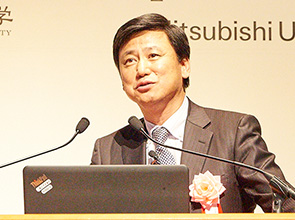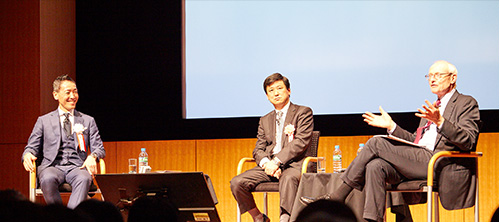Conference on Competitiveness
Session: "Opportunities and Challenges for Japanese Companies"
Mr. Kazunori Kuromoto, President of the ICT Solution Division, Director and Senior Executive Officer, Komatsu Ltd.
Presentation: "Komatsu's approach to the IoT Age"
 Komatsu has built its differentiation strategy on products, services and solutions. As a differentiation strategy focused on product performance, Komatsu visualized the operation of construction machinery, optimized maintenance, introduced a new service that proposes improvements in product usage, and installed KOMTRAX (Komatsu's remote monitoring system) as standard equipment 15 years ago.
Komatsu has built its differentiation strategy on products, services and solutions. As a differentiation strategy focused on product performance, Komatsu visualized the operation of construction machinery, optimized maintenance, introduced a new service that proposes improvements in product usage, and installed KOMTRAX (Komatsu's remote monitoring system) as standard equipment 15 years ago.As for solutions, Komatsu introduced an Autonomous Haulage System, enabling the unmanned operation of dump trucks for use in mining operations eight years ago, and has been equipping construction machines with intelligent technology and undertaking the visualization of construction work using "KomConnect," a cloud-based software service that functions as a platform for connecting all accumulated jobsite information. This is Komatsu's "SMARTCONSTRUCTION" solution.
Komatsu's services are a closed platform, as these services form part of the construction machinery value chain. Solutions, however, are an open platform, in that solutions have been adapted to fit into the customers' value chain because their purpose is to solve the customer's specific problems.
In either case, the key lies with the distributors, who serve as the customers' point of contact. We believe that each distributor's relationship with the customers should evolve from a mere transaction (i.e., the sale of Komatsu products) into a relationship. As customers gain confidence in Komatsu's ability to best meet their needs, they will consider our company's solutions to be their only option. We encourage our distributors to understand each customer's mission, vision and goals, and urge them to commit to helping customers succeed in meeting those goals. Komatsu makes a company-wide effort to help its distributors fulfill their commitment to each customer.
Komatsu is embracing the challenge of smart, connected products (SCPs), armed with both a customer-centric approach to systems development and a shift in mindset.

Discussion
Professor Michael E. Porter, Harvard Business School
Mr. Kazunori Kuromoto, President of ICT Solution Division, Director and Senior Executive Officer, Komatsu Ltd.
Facilitation: Professor Yoshinori Fujikawa, Hitotsubashi University Graduate School of International Corporate Strategy (Hitotsubashi ICS)
Mr. Kazunori Kuromoto, President of ICT Solution Division, Director and Senior Executive Officer, Komatsu Ltd.
Facilitation: Professor Yoshinori Fujikawa, Hitotsubashi University Graduate School of International Corporate Strategy (Hitotsubashi ICS)

"Opportunities and Challenges for Japanese Companies"
- Fujikawa:
- Professor Porter has raised questions about the impact of smart, connected products (SCPs) on companies and their competitive strategies. He says that a third wave of change is taking place, and that we must review our frameworks and concepts for viewing the future. He says we must reconsider the way we think about the structure of the industry, and that there is a need to expand the value chain, the mechanism for business activity.
Mr. Kuromoto, too, said that company value chains and customer value chains are intersecting, resulting in new value.
Until now, value chains were a closed system on the company side. It was separate from post-sales customer activities. However, with smart, connected products, the value chain will not end at sales, but continue further.
I would like to ask Professor Porter and Mr. Kuromoto about the disappearing industry boundaries. First, I would like to ask Mr. Kuromoto, which industry do you think Komatsu belongs to now?
Professor Porter, strategy begins with defining the industry, but defining industries is becoming more and more difficult. We would like your advice about how we should view the industry.
- Kuromoto:
- Komatsu has gone beyond the manufacturing industry. It is also a part of the service industry, and as augmented reality (AR) and artificial intelligence (AI) become central to our value chain moving forward, we must also become a part of the IT industry. Defining the scope of our industry has surely become tough, but we are always aware that our customers are miners and construction companies. So long as we remember this, we are fine being a part of any industry, and if you think of us as being in the mining business support industry, then our industry will remain as clear as before.
- Fujikawa:
- Professor Porter, won't it be difficult to define the industry your company operates in, which is the first step of Five Forces Analysis?
- Porter:
-
There will be no change in this basic principle of competition, that industry structure determines average profitability and the nature of competition.
SCPs will provide new opportunities by connecting with other products and information. The scope of industries will change drastically when a synergy greater than a simple exchange of information and coordination of activities takes place.
The functions involved in the value chain will not change, but more methods will be available and the way of working will, therefore, change. Companies that have been using the same methods for decades will be forced to make new choices.
- Fujikawa:
- Fundamental rules and logic will remain the same, but choices will increase. This will mean that the combination of such choices will constitute the essence of strategy-making.
Mr. Kuromoto, Professor Porter says that the value chain will change. When that happens, human behavior, including organizational structure, ways of working, and interaction with customers must also change. The movement of people is, by no means, easy in Japanese companies. How does Komatsu plan to proceed with regard to this matter?
- Kuromoto:
- Komatsu has two ICT divisions. One is the internal information strategy department and the other is the ICT solutions department for customers, directed particularly at distributors. The three aspects that I explained earlier will not work if these two departments are not in sync. Brand management activities are a pillar of our business. We consider demands emerging around the world and align our R&D, marketing, support and finance divisions accordingly. We can slowly create an adaptable organization if we continue doing this for five to ten years. Komatsu works in an inflexible manufacturing industry, and cannot change all of a sudden. Drastic changes in the manufacturing division could rock the foundation of our business.
- Fujikawa:
- Professor Porter, it would be difficult to make drastic personnel changes if we consider labor practices in Japanese companies. What can we do to make rapid progress in the organizational changes required for adapting to SCPs?
- Porter:
- Making changes in human resources and organizational structure will, perhaps, be the biggest challenge for Japanese companies. The boundary between IT and R&D will become blurred, and software engineers might have to participate in product development. Companies will also need data scientists to interpret data. Japanese companies have impressive foundations, but to leverage this technology they must overcome the challenges posed by lacking skill sets and resistance to change.
- Fujikawa:
- Professor Porter, you mentioned earlier that the number of Porter Prize winners leveraging smart, connected products could rise. Maybe the Porter Prize itself will need to evolve as its evaluation criteria become more and more difficult. Finally, I would like to ask you to say a few words for the future recipients of the Porter Prize.
- Kuromoto:
- There is no doubt that SCP is going to be a huge trend. I hope that companies will hop on board quickly and use this opportunity to forge ahead.
- Porter:
- Successful companies see opportunity in change. Unsuccessful companies consider change a problem. You will see new opportunities if you look at the world through the SCP lens.
Winners PDF
- 第17回 ポーター賞受賞企業・事業 PDF (All of the award company in this year are published. )





